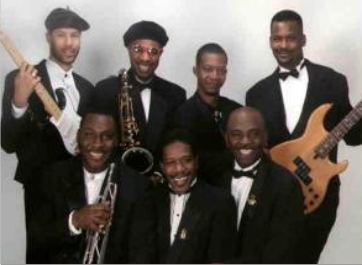
It goes beyond the awe over the musical versatility, the wide range of singers, the splendid dance routines, and the up-to-the-minute engineering. Many other groups are as accomplished as this. The significant difference lies in the gift of the Voltage Brothers to change the crowd from passive listeners and automatic dancers into people who project their own energy back to the band. The Voltage Brothers appear to be two groups with one sound system even the personnel seems to change from song to song. Guests are sent from 1920 to 1990 with stops at the Cotton Club and the Country Club. They may meet The Temptations, The Drifters, James Brown, Otis Redding, or Elton John. This group can go from Big Bands to Little Richard. They can play the Top 40 for each of the last 20 years or present a living showcase of Black musical forms. Whatever the beat, lyrics, composer, or era, the Voltage Brothers will blend them into your night of music. Whether you “Take the ‘A’ Train” or “Do the Wild Thing,” the Voltage Brothers will conduct you. Whatever the beat, lyrics, composer, or era; Voltage will blend them into your night of music. Since relocating to Atlanta, the popularity of this band grew with the fans it first attracted at college campuses, clubs and resorts. As these fans planned debutante balls and cotillions, joined country clubs, were married, and so on, the request went out to get the Voltage Brothers to guarantee the success of the occasion. The incredible variety of functions the band has catered to only offers more proof of the band’s universal appeal in a universe of settings. Twenty-one years ago a band of very young teens in Rochester, New York, known as The Destinations were a community wonder. They were destined to be flimflammed by a succession of opportunists until they learned to pick their people as skillfully as they picked their strings. They had heard of Jerry Griffin, a goodhearted Ex-Marine and Vietnam veteran who had been working with a street gang. When asked to become the Destinations’ manager, Griffin wanted no part of their proposal. He declared that he knew nothing about the music business, i.e. equipment, getting gigs, managing, or recording. He did, however, know about youth and how to get them to work together, to achieve their best and to survive in the process. Eventually he gave in. Griffin could not resist their appeal anymore than their audiences. They were so young when they started to make money and draw huge crowds that they had exhausted the possibilities of their home town while still in high school. What would ordinarily be teenage fantasy was simple logic when they begged Griffin and their parents to test their musical muscle in Los Angeles. The six-month odyssey in their own faltering bus, often without food or shelter, left them with a legacy of confidence, discipline and unity that most bands never find; bands who may have formed yesterday and could break up over a song tomorrow. The group, now called Funky Heavy, resettled in New Jersey at a time when discos were replacing live music. Gigs were hard to come by, but to audiences hungry for live music, the band created a sensation. Five years and three agents later, they were hired to tour with the Kool Jazz Festival. They appeared with The O’Jays, Kool & The Gang, Teddy Pendergrass, and Gladys Knight and The Pips. Again, they saw California, as well as Texas, and much of the South. At the end of the tour the decision was made to once again relocate. Based on thoughtful discussion, each individual voted, and Atlanta was chosen. They had recently appeared at Braves Stadium and liked the city. College tours followed, leading eventually to NACA (National Association for Campus Activities) showcases and in 1986 the Campus Entertainment Award, also bestowed upon the Oak Ridge Boys. This new career direction with more and better bookings can be attributed to the astute and thoughtful guidance of Dennis Huber, President of East Coast Entertainment, Inc. Their recording career began while they were still in New Jersey, with two albums produced by Lifesong/CBS Records. A third album was produced in 1985 when the Voltage Brothers traveled from Atlanta to MTM Records in Nashville. They changed their recording medium from vinyl to film during the summer 1987 in Myrtle Beach, S.C. with an appearance in the movie “Shag,” along with Phoebe Cates, Carrie Hamilton, and Bridget Fonda. The band portrayed “Big Dan and The Sand Dollars,” a vintage 1960s group who performed the classics, “Stay” and “Sixty Minute Man.” Released by the Hemdale Corporation in 1989, it is on videotape, and has been featured on Cinemax. In July 1990, the Brothers reached international audiences and international recognition performing in Yokohama, Japan. They anticipate many, many returns. Now more and more people, worldwide, are setting their social clocks by the Voltage Brothers’ itinerary!


Follow Us